Key takeaways:
- Empathy in families fosters emotional support and strengthens connections through open discussions about feelings and shared experiences.
- Children’s emotional development benefits from practicing empathy, which enhances their social skills and builds healthy relationships.
- Storytelling, role-playing, and family activities like volunteering promote understanding of different perspectives and cultivate compassion.
- Creating structured family empathy plans, such as empathy nights and listening sessions, enhances communication and nurtures emotional intelligence across generations.
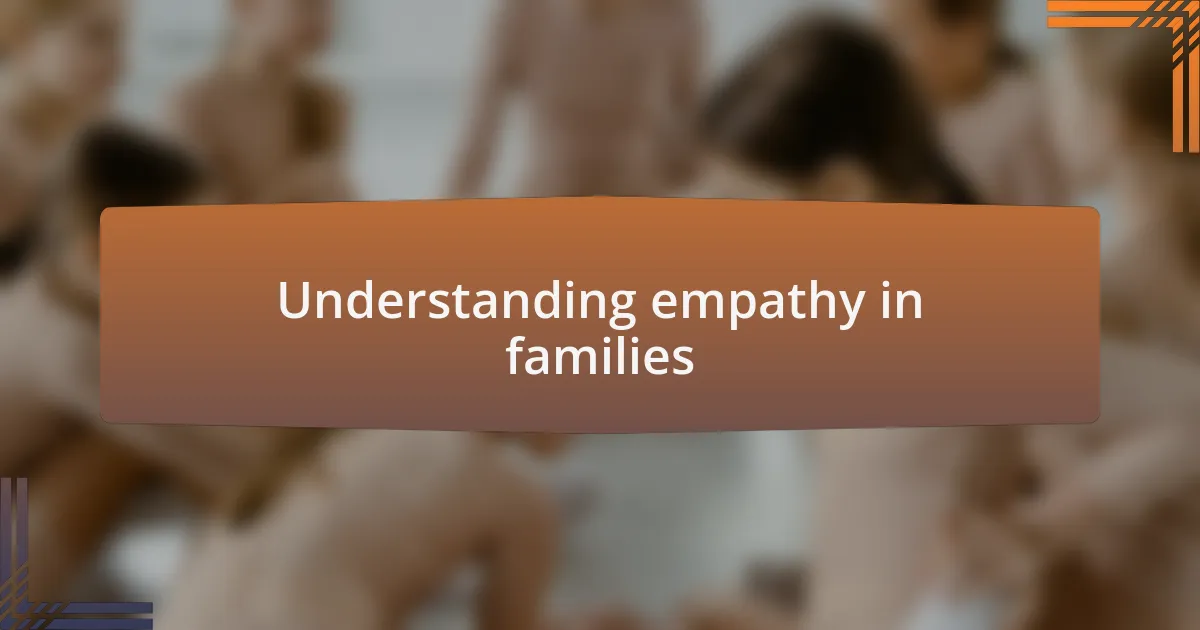
Understanding empathy in families
Empathy in families is more than just the ability to understand each other’s feelings; it’s about actively acknowledging and valuing those emotions. I remember a time when my child came to me upset about a conflict with a friend. Instead of reacting immediately, I paused and asked, “How did that make you feel?” This simple question opened a door to deeper understanding and connection, showing that I truly cared about their experience.
I often reflect on the importance of family discussions around emotions. Have you ever noticed how a shared family story, even a difficult one, can evoke feelings and foster bonding? When my family gathers for dinner, we sometimes recount moments that made us laugh or cry. These gatherings are filled with laughter and occasionally poignant silences, reminding us that empathy strengthens our ties and creates a safe space for expressing vulnerability.
It’s essential to remember that empathy is not a one-time act but a continuous journey. I’ve found that by modeling empathetic behavior in everyday situations, like listening to my partner’s frustrations after work, I create an environment where everyone feels comfortable sharing their thoughts and feelings. How can we cultivate more of these moments? By making empathy an everyday practice, families can weave a rich tapestry of emotional support that spans generations.
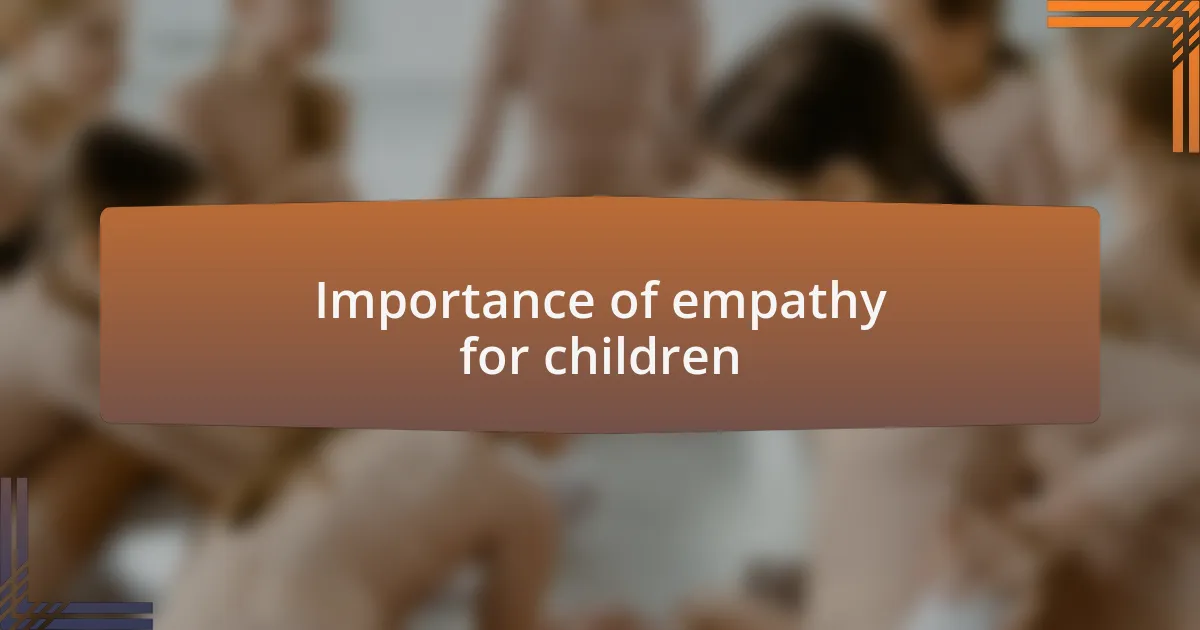
Importance of empathy for children
Empathy is vital for children’s emotional development and social skills. I’ve witnessed firsthand how my child learned to navigate friendships by recognizing when peers feel sad or happy. One day, during an art class, they noticed a classmate who seemed left out. Instead of joining the larger group, my child approached that peer and invited them to collaborate on a project. This simple act of kindness was rooted in empathy, and it not only strengthened their friendship but fostered compassion in a young heart.
As kids practice empathy, they build a foundation for healthy relationships. I’ve often found myself encouraging discussions about feelings after school. When my child shares their experiences, it allows me to highlight moments where empathy could shine through. “What was going on with your friend today? How do you think they felt?” These questions not only prompt reflection but also help my child make connections between their actions and the emotions of others.
Empathy also enriches a child’s sense of self. I’ve seen my child’s confidence grow when they understand and empathize with others. During a group project, they had the chance to lead, but instead of just directing, they listened and incorporated everyone’s ideas. This act showed that empathy is not about being the loudest or most assertive; it’s about connecting on a human level. Isn’t it amazing how these little moments create a ripple effect, influencing not just one child but an entire community?
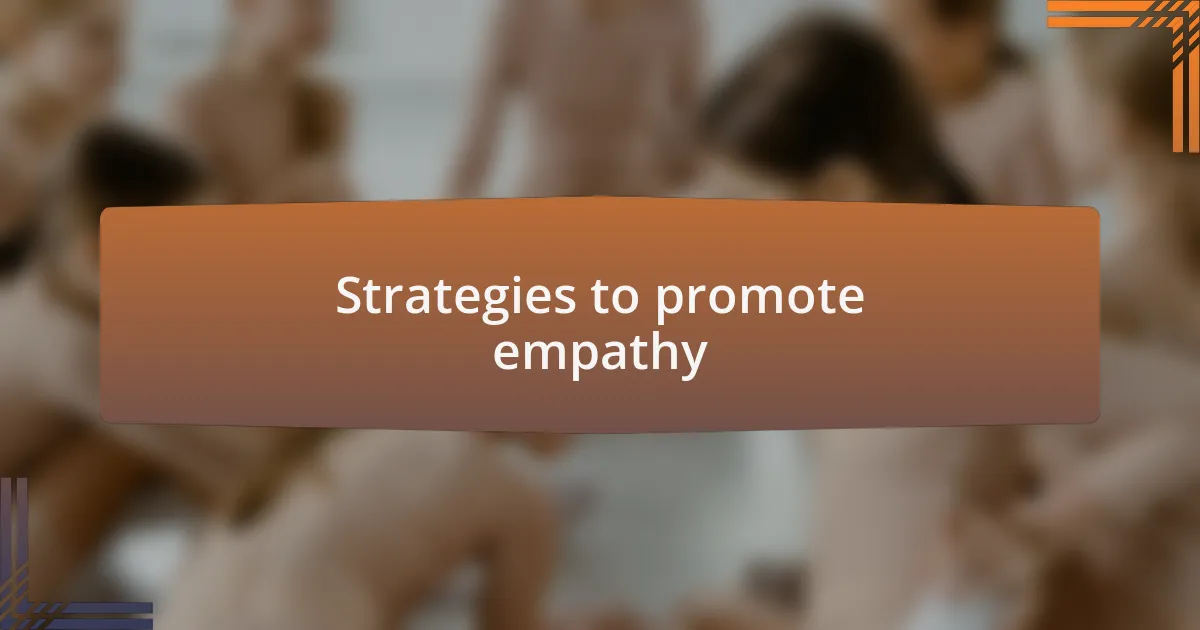
Strategies to promote empathy
One effective strategy to promote empathy is through storytelling. I often gather my family to share stories about our day, but instead of just recounting events, we focus on the feelings involved. I remember one evening, my child shared a story about a difficult day at school. I encouraged them to think about how their teacher might have felt while managing a busy classroom. This not only deepened our conversation but also opened their eyes to perspectives beyond their own.
Additionally, role-playing can be a fun and impactful way to cultivate empathy. I once created simple scenarios involving diverse characters with different emotions for my child to act out. For instance, we played out a scene where one character felt left out during playtime, and my child had to respond. Watching them process the scenario and come up with a compassionate response showed me the powerful effect of stepping into someone else’s shoes, even in a playful context.
Lastly, volunteering as a family can be a profound experience that nourishes empathy. I planned a Saturday at a local community garden where we helped out together. As my child noticed how grateful the beneficiaries were for our small contributions, I could see a light of understanding in their eyes. They began to grasp the importance of being aware of others’ struggles and joys. Isn’t it wonderful how shared experiences like this can develop a lifelong commitment to empathy?

Activities to build empathy
Engaging in art projects together can also be a gateway to fostering empathy. I remember a day when my child and I sat down with some paints and canvases, each tasked with expressing our feelings about a specific topic. As we painted, I shared my struggles with balancing work and family. Watching my child process my emotions through their artwork was eye-opening; it highlighted how creativity can help us connect to one another’s experiences. Have you ever noticed how art can speak volumes when words fall short?
Another effective activity is discussing current events as a family, focusing on how people might feel in various situations. I often pull up news stories that illustrate different human experiences, which can lead to deep conversations. One time, we talked about a story of a family losing their home to a natural disaster. My child’s reaction surprised me—they immediately started brainstorming ways we could help. This not only revealed their compassionate side but also prompted them to think critically about what others might be going through.
Cooking meals from different cultures together is another enriching way to cultivate empathy across generations. One weekend, we decided to prepare a traditional dish from a country facing hardships. As we chopped vegetables and shared stories about the culture, I guided my child to think about the daily lives of families in that country. The experience not only filled our home with delightful aromas but also sparked meaningful conversations, making my child appreciate the richness of diversity and the common threads that bind us all. Don’t you think that sharing food can bring people together in ways we often overlook?

Communicating across generations
Communicating across generations can sometimes feel like navigating a complex maze, but it’s essential for cultivating empathy. I vividly remember a time when I asked my grandparents about their childhood experiences during significant historical events. Their stories unfolded a tapestry of emotions, and I felt an unexpected connection to their struggles and triumphs. Have you ever stopped to think about how sharing our past can bridge the gap between young and old?
One memorable family dinner, I set aside time for each generation to share their favorite memories. As my children listened to their grandparents recite tales from decades ago, I saw their eyes widen with wonder. It struck me how powerful storytelling can be in fostering understanding and compassion. Have you noticed how a simple story can reveal the values and beliefs that shape us?
Moreover, using technology has become a valuable tool in facilitating communication between generations. I encouraged my teens to teach their grandparents how to use video calls, which turned out to be a delightful experience. Watching my kids patiently guide their grandparents through the process sparked laughter and a sense of teamwork. Isn’t it interesting how technology can create shared learning moments, ultimately building empathy through connection?
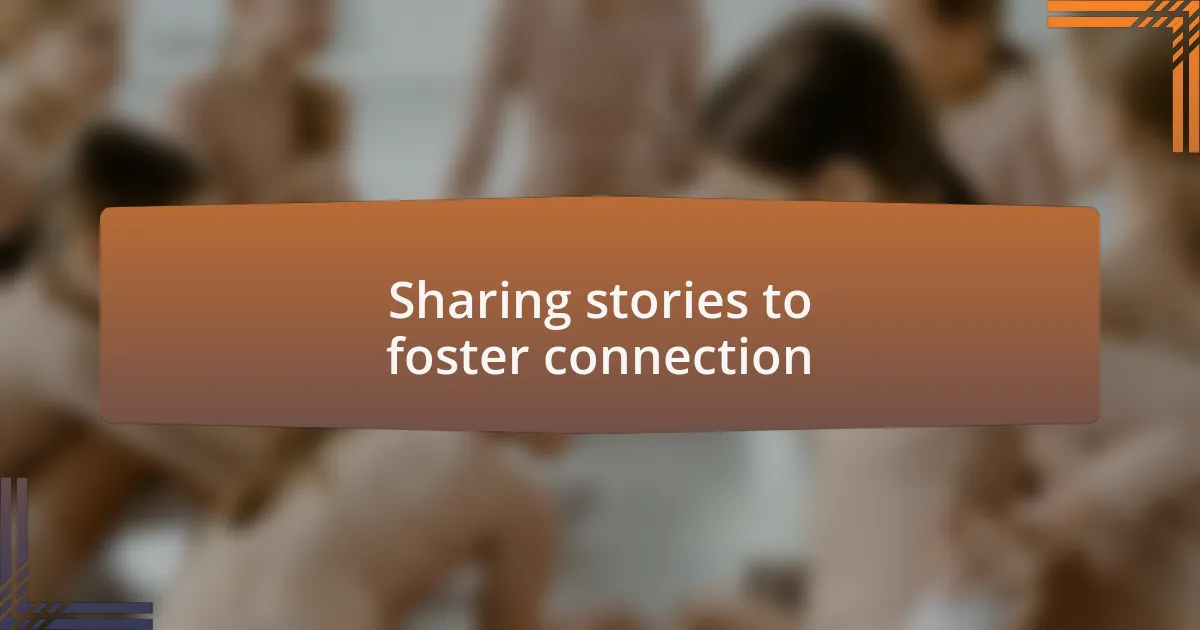
Sharing stories to foster connection
One evening, I gathered my children and shared a story from my own childhood, explaining why certain family traditions held deep meaning for me. As I spoke, I could see the curiosity in their eyes, sparking questions about their own lives and experiences. This back-and-forth not only deepened their understanding of our family’s history but also allowed them to express their feelings, bridging our diverse generational experiences.
I remember a family gathering where my aunt decided to share her challenges raising children during her own upbringing. Her honesty about the struggles she faced resonated with my children, who found parallels in their own challenges. It was an eye-opening moment; suddenly, the generational divide felt smaller, and empathy flowed freely as they realized that no matter the era, parenting can be a tough journey.
On another occasion, I suggested we all write down a memory that made us feel grateful, then share them with one another. Watching my kids listen intently as their elders opened up about moments of joy connected us in unexpected ways. Have you ever noticed how vulnerability in storytelling invites openness? It fosters an environment where each generation feels not just heard, but truly understood.
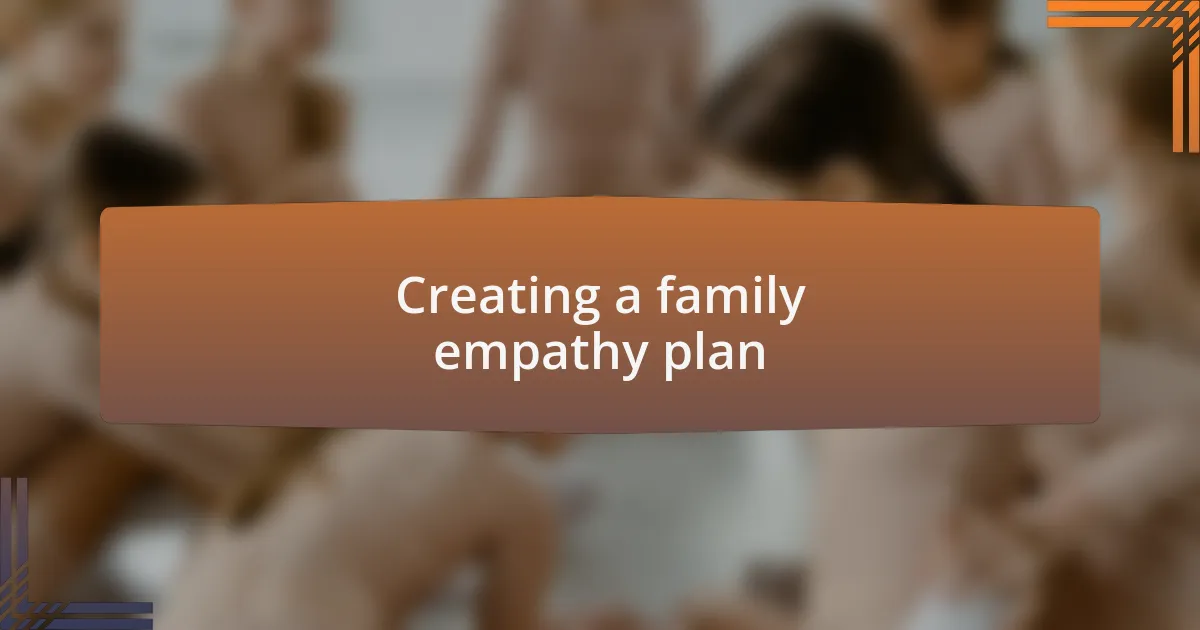
Creating a family empathy plan
Creating a family empathy plan requires intention and structure. I once sat down with my family to design an empathy calendar, where each month we committed to exploring a new theme, such as kindness or understanding different perspectives. This simple act not only gave us a shared goal but also provided opportunities to engage in meaningful conversations, allowing us to reflect on how those themes play out in our daily lives.
One of the activities we included was “family empathy nights,” where we would gather to watch films that highlight various social issues. After the movie, we would dive into discussions, sharing our thoughts and feelings on the characters’ experiences. It was powerful to witness how my children started to empathize with others’ struggles, drawing connections to their own lives. Have you considered how storytelling through film can create empathy?
I also introduced a practice of “listening sessions” during our family gatherings. In these sessions, each person takes turns sharing a challenge they’re facing, while the rest of us simply listen without interrupting or offering solutions. This approach opened up remarkable dialogues, allowing my children to see that everyone has their own battles, fostering a deeper sense of compassion among us. In my experience, such practices can truly shift family dynamics and nurture emotional intelligence across generations.